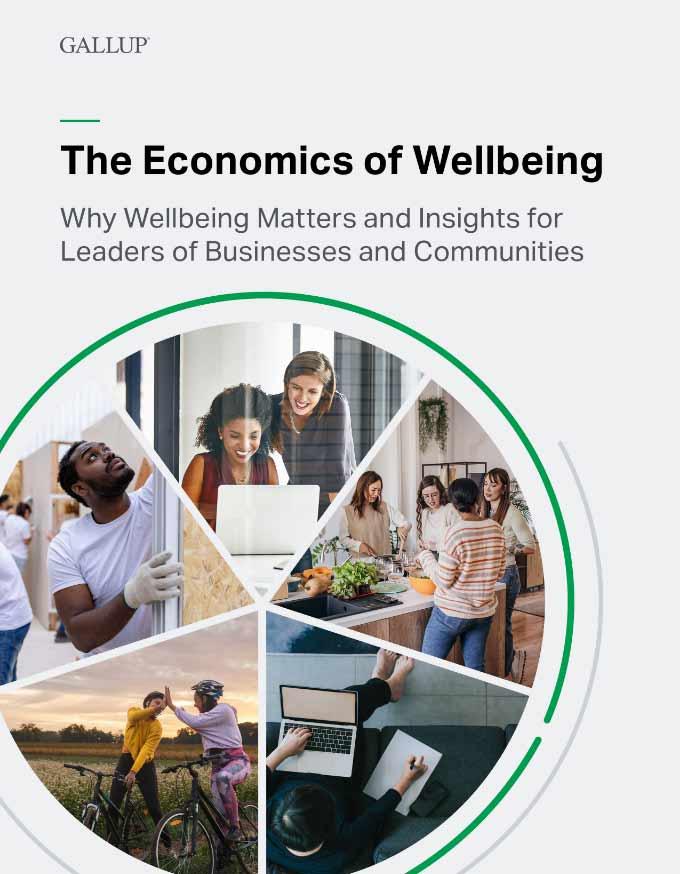Wellbeing
Gallup explores the impact of wellbeing and provides insightsfor leaders of businesses and communities.
The Economics of Wellbeing: Why Wellbeing Matters and Insights for Leaders of Businesses and Communities
Wellbeing matters. Subjective wellbeing -- as measured through survey research -- has been linked to an extensive array of outcomes relevant to communities and organizations. Among residents of communities, wellbeing is correlated to healthcare utilization, violent crime, property crime, high school graduation rates, teen pregnancy, unemployment rates and life expectancy metrics, among others. Wellbeing has even been linked to county-level shifts in voting patterns for the U.S. president.
In workplaces, wellbeing closely predicts absenteeism, performance, turnover, employee engagement and healthcare utilization.
Ultimately, high-wellbeing communities and workforces are more likely to be thriving across five critical elements. This finding allows leaders of lower-wellbeing groups to study and adopt the distinguishing features of high-wellbeing groups to enhance the overall health of their employees and constituents.

Download the report to learn more.
Key Findings
Given the importance of wellbeing to shared economic viability, leaders of communities and organizations alike can make a substantial difference in the wellbeing -- or lack thereof -- of their constituents.
Wellbeing and Communities
Communities play a crucial role in population wellbeing through public policies and business actions. Successful communities cultivate a culture of wellbeing, with leaders from various sectors prioritizing it.
Transit Scores and Walk Scores are closely related to reduced depression rates and favorable perceptions of housing quality. Residents of high-wellbeing communities exercise more, have better physical and social wellbeing, and experience lower rates of obesity and chronic health conditions compared to lower-wellbeing communities.
Wellbeing and Chronic Disease
A study tracking 3,654 working adults over three years reveals that lower wellbeing is linked to 159 extra new chronic conditions per 1,000 people. This amounts to an estimated 19.1 million new chronic conditions across the entirety of the U.S. full-time working population at the end of the three-year period as a function of poor or inconsistent wellbeing.
The incremental chronic conditions measured among those workers with lower wellbeing results in an estimated $101.5 billion in new healthcare costs each year.
Wellbeing, Mental Health and Opioids
Global unhappiness, including feelings of anger, stress, worry and sadness, has been steadily increasing over the last decade, reaching a new high in 2021. Globally, nearly 40% of adults over the age of 15 either suffer from significant anxiety or depression or have a close friend or family member who does.
The associated opioid crisis has imposed a substantial economic burden on the U.S., with an estimated $631 billion drained from the economy between 2015 and 2018, primarily due to lost lifetime productivity.
Wellbeing, Depression and Anxiety
Depression vs. Wellbeing: Which Comes First?
In longitudinal studies, each significantly predicts the future state of the other, but wellbeing has a 54% stronger causal influence on depression than the other way around.




Wellbeing and Workplace
Improving employee mental health is a crucial concern, with a need to understand key factors and avoid harmful managerial practices. Employee engagement is foundational in enhancing mental health and positively impacts organizations.
Engaged employees are significantly more likely to report their job having a positive impact on their mental health, but only 21% of U.S. employees feel strongly that their organization cares about their wellbeing. Among the five elements of wellbeing, career wellbeing exhibited the strongest inverse relationship with future drug overdose rates.
Explore Gallup’s Wellbeing Insights
This is how we change the world – a little to a lot every day – in the public sector. Explore more of our wellbeing insights.










